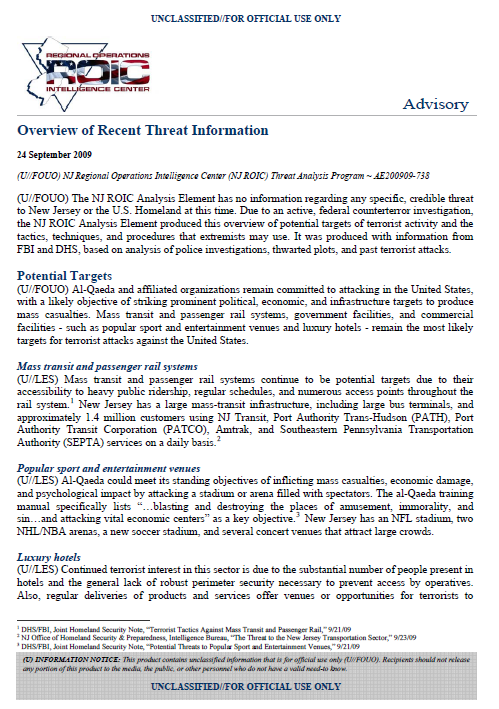 NJ Regional Operations Intelligence Center (NJ ROIC)
NJ Regional Operations Intelligence Center (NJ ROIC)
- 5 pages
- For Official Use Only
- September 24, 2009
(U//FOUO) The NJ ROIC Analysis Element has no information regarding any specific, credible threat to New Jersey or the U.S. Homeland at this time. Due to an active, federal counterterror investigation, the NJ ROIC Analysis Element produced this overview of potential targets of terrorist activity and the tactics, techniques, and procedures that extremists may use. It was produced with information from FBI and DHS, based on analysis of police investigations, thwarted plots, and past terrorist attacks.
Potential Targets
(U//FOUO) Al-Qaeda and affiliated organizations remain committed to attacking in the United States, with a likely objective of striking prominent political, economic, and infrastructure targets to produce mass casualties. Mass transit and passenger rail systems, government facilities, and commercial facilities – such as popular sport and entertainment venues and luxury hotels – remain the most likely targets for terrorist attacks against the United States.
…
Potential Tactics, Techniques, and Procedures
(U//FOUO) The information provided by FBI and DHS also highlighted potential terrorist tactics, techniques, and procedures that may be of concern to New Jersey law enforcement and homeland security officials. These areas include:
Homemade explosives
(U//LES) Violent extremists have used explosives made from ingredients readily available at retail stores in the United States or over the Internet. Triacetone triperoxide (TATP) and hexamethylene triperoxide diamine (HMTD) are two common homemade explosives built with ydrogen peroxide.
(U//LES) TATP and HMTD are extremely sensitive to impact, friction, static/sparks, and heat, and may react violently to field drug testing. Similarities in appearance and production methods may cause first responders to mistake them for clandestinely manufactured narcotics (i.e., methamphetamine), creating a potential, additional hazard.
(U//LES) Chlorate-based explosive formulations are also a possible option for terrorists. The demonstrated effectiveness of explosive compositions using ammonium nitrate and hydrogen peroxide has raised law enforcement awareness of these materials and increased security measures. In order to adapt and avoid detection, terrorists are exploring other options, such as using potassium chlorate (white, odorless powder) or sodium chlorate (yellow, odorless powder) when making IEDs.
(U//LES) High-profile, historic examples include the London attacks in July 2005, in which suicide bombers used homemade hydrogen-peroxide based explosives to carry out attacks,9 and the December 2001 attempted attack by “shoe-bomber” Richard Reid, who attempted to detonate a TATP explosive device while flying from Paris to Miami.
…
Suspicious Activity Indicators
(U//LES) Suspicious activity is not always actionable, but when placed in context with additional behaviors or with other information, may indicate a potential threat.12 The following are some examples of potential suspicious activity:
General
• There is no typical physical appearance for a terrorist operative – al-Qaeda actively seeks to diversify its “operatives”
• Bulky clothing inconsistent with the weather; frequent, brief contact with other individuals; etc.
• Individuals taking panoramic photos/videos – the al-Qaeda Manual stresses that if still photos are taken, prints should be cut and assembled together in a mosaic
• Individuals taking notes or drawing diagrams of critical infrastructure
• Repeat visits to take photos/video of the same landmark
• Measuring by counting footsteps between entrances, security posts, security cameras, etc.
• Questioning security personnel on sensitive subjects (shift changes, what cameras film, etc.).
• Possession of multiple identification documents
• Filming entry and egress points, traffic barriers, or security personnel
• Possession of sensitive schedules, blueprints, evacuation plans, codes, etc.
